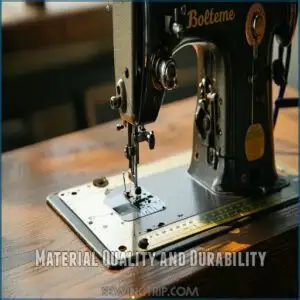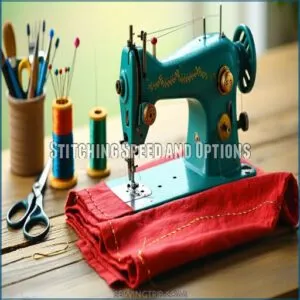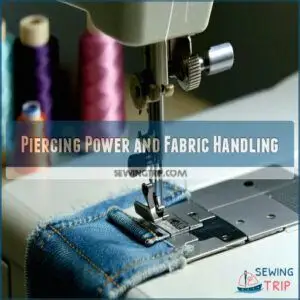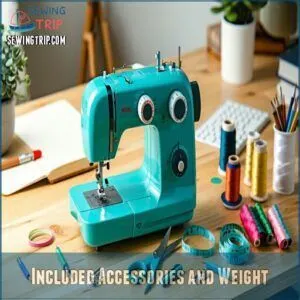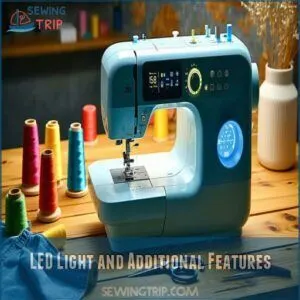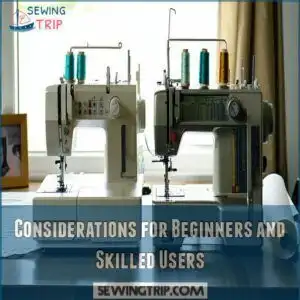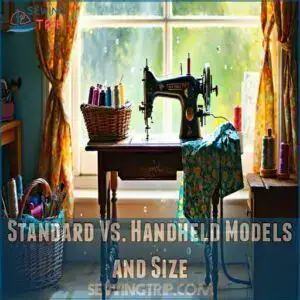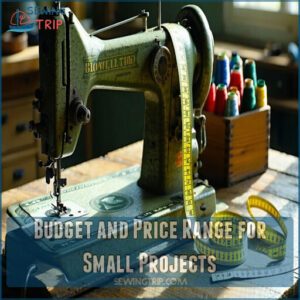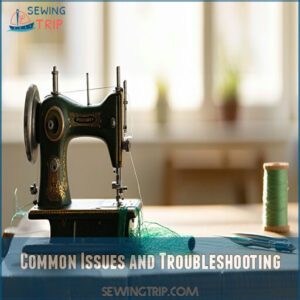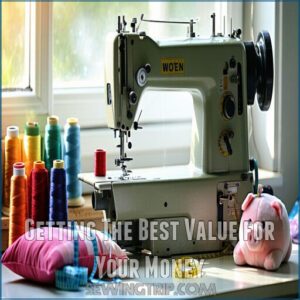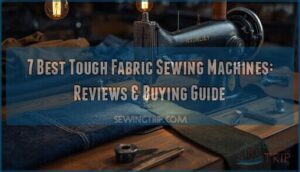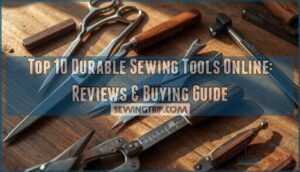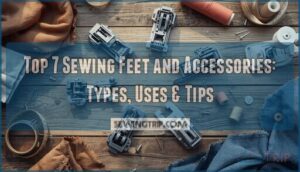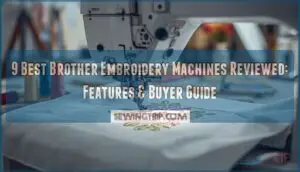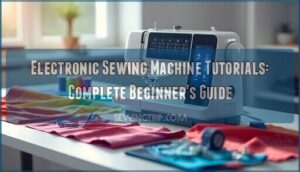This site is supported by our readers. We may earn a commission, at no cost to you, if you purchase through links.
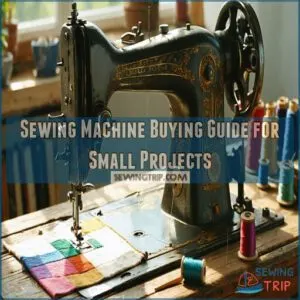 When choosing a machine, you’ll want to evaluate material quality, stitching speed, and piercing power.
When choosing a machine, you’ll want to evaluate material quality, stitching speed, and piercing power.
A good machine should have adjustable speed, basic stitches, and reliable piercing power.
You’ll also want to think about included accessories and weight, and consider what features matter most to you, and how will you use your new machine – that’s what you’ll need to figure out next, considering budget options start at $25, but reliable models typically cost between $40 and $60.
Table Of Contents
- Key Takeaways
- Essential Features for Small Projects
- Choosing The Right Machine for Small Projects
- Top 8 Mini Sewing Machines for Small Projects
- 1. Portable Mini Sewing Machine for Beginners
- 2. Singer Start 1304 Sewing Machine
- 3. Mini Sewing Machine Combo Kit
- 4. Portable Sewing Machine for Beginners
- 5. DONYER Power Portable Sewing Machine
- 6. Beginner Sewing Machine Full Set
- 7. Speedy Stitcher Sewing Awl
- 8. Singer Stitch Sew Quick 2 White Sewing Machine
- Common Issues and Troubleshooting
- Getting The Best Value for Your Money
- Frequently Asked Questions (FAQs)
- Conclusion
Key Takeaways
- You’ll want to evaluate a sewing machine’s material quality, stitching speed, and piercing power to ensure it can handle your small projects easily and effectively.
- When choosing a machine, consider your budget, with reliable models typically costing between $40 and $60, and think about what features matter most to you, such as ease of use, stitch options, and portability.
- You should look for a machine with adjustable speed, basic stitches, and reliable piercing power, and don’t forget to check the included accessories, weight, and warranty coverage to get the best value for your money.
- To maintain your mini sewing machine, you’ll need to regularly clean and oil it, check the bobbin and needle, and store it properly to keep it running smoothly and extend its lifespan, which can be around 5-7 years with proper care.
Essential Features for Small Projects
You’re looking for a sewing machine that can handle small projects, and you want to know what features to look for.
When choosing a machine, you’ll want to evaluate essential features like material quality, stitching speed, and piercing power to guarantee you can complete your projects easily and effectively.
This approach will help you find a machine that meets your needs and allows you to work on your projects with ease.
Material Quality and Durability
You want a mini sewing machine that lasts.
Consider metal frames for stability and longevity. Check warranty coverage and durability reviews.
Look for reinforced feet and a solid base plate.
Key factors include:
- Material quality
- Build quality
- Durability reviews
- Metal internal parts
- Warranty coverage
Stitching Speed and Options
You’ll find mini machines with adjustable speed controls, offering 8-12 stitches per minute.
Basic machines have straight stitches, while mid-range ones include zigzag and decorative patterns.
Consider a mini sewing machine review before purchasing.
Check for reverse stitch feature for securing seams, and examine the sewing needs.
Piercing Power and Fabric Handling
You need reliable piercing power for your mini sewing machine.
Check the needle strength and motor capability to handle various fabrics. Match your needle size to the fabric type for best results.
Machines require adequate sewing machine piercing power to sew thick fabrics.
Most mini machines handle lightweight to medium fabrics, but struggle with thick ones like denim or leather, requiring good fabric handling and piercing power.
Included Accessories and Weight
You’ll love a mini sewing machine with useful accessories.
Look for:
- Accessory Kits
- Machine Weight
- Portable Designs
- Storage Compartments
- Power Options.
A portable sewing machine should be lightweight, making it easy to carry.
Included accessories can make a big difference in your sewing experience.
Finding the right mini sewing machine accessories is important for successful small projects.
LED Light and Additional Features
You’ll appreciate LED lighting, built-in storage, and thread cutters on your portable sewing machine.
These features make sewing easier, especially with automatic needle threading and compact designs, perfect for a portable sewing machine with LED lighting and storage compartments.
Choosing The Right Machine for Small Projects
You’re looking for the perfect sewing machine for small projects, and choosing the right one can be overwhelming.
You’ll want to evaluate what features are important to you, such as ease of use, stitch options, and portability, to find the best machine for your needs.
Considerations for Beginners and Skilled Users
You’re choosing a sewing machine.
Consider your experience level and project goals. As a beginner, look for simple machines with easy threading.
Advanced sewers need adjustable tension and multiple stitches.
Your skill level and user needs matter when selecting the best sewing machine for beginners and small projects.
Standard Vs. Handheld Models and Size
When discussing mini sewing machines, you’ve got two main options: standard tabletop models and handheld designs.
While tabletop machines provide stability for consistent stitching, handheld versions offer ultimate portability.
- Standard models weigh 15-20 pounds but deliver professional results.
- Handheld machines are super light at 2-5 pounds.
- Compact frames fit perfectly in small spaces.
- Mini designs store easily in drawers or cabinets.
Your sewing space will help determine which style works best, considering factors like portability.
Automatic Needle Threading and Bobbin System
While size matters, let’s talk about what’ll save your sanity – threading your machine!
You’ll find automatic needle threading a game-changer, especially when your eyes are tired.
Consider features like automatic thread cutting to further streamline your sewing process.
Top-drop bobbins make loading a breeze compared to front-loading ones, and automatic bobbin winding means you won’t waste time hand-winding threads.
These features boost your sewing efficiency, letting you focus on creating rather than fiddling with thread management issues.
Presser Foot and Free Arm for Fabric Handling
Threading a machine is just the start – now let’s look at what keeps your fabric flowing smoothly as you sew.
Your presser foot and free arm are like your project’s best friends, helping you create perfect stitches every time.
- A snap-on presser foot system lets you switch between different feet in seconds
- The free arm makes sewing sleeves and cuffs feel like magic
- Specialty presser feet turn tricky tasks like zippers into a breeze
- Good fabric feeding means your seams stay straight without pulling
Think of your presser foot as your fabric’s personal guide, keeping everything aligned while you work, which is crucial for achieving confidence in your sewing skills. With the right setup, you’ll handle any small project with confidence.
Budget and Price Range for Small Projects
Money matters when picking your small sewing companion.
You’ll find mini machines ranging from $25 to $100, with the sweet spot for reliable models falling between $40-60.
Consider exploring cheap sewing machine price options online.
While budget options under $30 exist, they often lack durability.
For the best value, aim for mid-range machines ($50-75) that balance quality and features.
Premium models ($75-100) offer extras you mightn’t need.
Top 8 Mini Sewing Machines for Small Projects
You’ll find the perfect mini sewing machine for your small projects in our handpicked list of top 8 favorites that won’t break the bank.
Whether you’re planning to hem pants, fix buttons, or create simple crafts, these compact machines offer just the right features you need to get started with your small projects.
1. Portable Mini Sewing Machine for Beginners
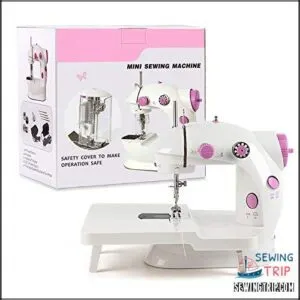
Looking for a portable sewing machine that won’t weigh you down? NEX’s mini machine is your new crafting companion.
At just 2 pounds, you’ll barely notice it in your bag as you head to sewing class or craft night.
- Dual speeds let you start slow and work up to faster stitching as you gain confidence
- Built-in LED light helps you see every stitch clearly, even in dim lighting
- Extension table gives you extra workspace for bigger projects
Power it with the included adapter or pop in four AA batteries for complete portability. Perfect for beginners and kids learning sewing basics, this compact machine handles straight stitching like a champ, making it a great tool for sewing class or craft night.
2. Singer Start 1304 Sewing Machine
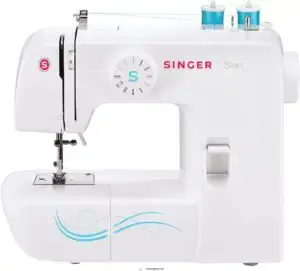
Want a sewing machine that won’t leave you scratching your head? The SINGER Start 1304 packs just what you need without the confusion.
You’ll get 6 basic stitches and 57 stitch applications – perfect for learning without feeling overwhelmed.
At 7 pounds, you can easily carry it to sewing class or move it around your home.
The machine’s metal frame means it’ll last through years of projects, while the automatic bobbin winding saves you time and frustration.
SINGER’s 25-year warranty shows they stand behind their product.
Plus, the included accessory kit gives you everything to start sewing right away.
Best For: Beginners and hobbyists wanting a reliable, straightforward machine for basic projects.
3. Mini Sewing Machine Combo Kit
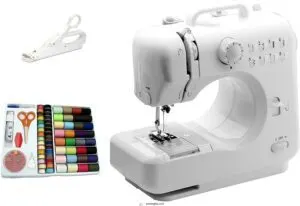
While the Singer Start 1304 offers robust features, the Michley Mini Sewing Machine Combo Kit brings a whole new level of portability to your crafting adventures.
You’ll love how this compact sewing machine comes with everything you need to start stitching right away. The kit contents include a two-thread lockstitch system and user-friendly magnetic bobbin that makes threading super easy.
Mini motors power through basic fabrics smoothly, though they won’t handle leather or heavy materials. The machine cases and accessory bundles provide convenient storage for all your sewing notions.
A built-in work light helps you see clearly, while the adjustable spool pin fits larger thread spools. Perfect for beginners tackling small sewing projects, you’ll find the included practice fabric gets you started immediately.
4. Portable Sewing Machine for Beginners
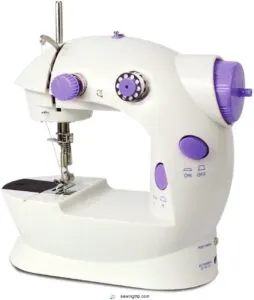
The HAITRAL Portable Sewing Machine makes starting your creative journey a breeze.
At just 2.2 pounds, this lightweight mini model won’t hog your sewing space.
You’ll love how it comes pre-threaded, taking the guesswork out of setup.
The foot pedal gives you smooth control over your stitching speed – perfect for small sewing projects.
While it’s budget-friendly, there are some trade-offs.
You won’t find a reverse stitch, and it’s not made for thick fabrics like denim.
Here’s a beginner tip: use high-quality thread to prevent snapping.
Best For: First-time sewists wanting an affordable, portable machine for light fabric projects.
If basic alterations and simple DIY crafts are your goal, this best sewing machine for beginners fits the bill.
5. DONYER Power Portable Sewing Machine
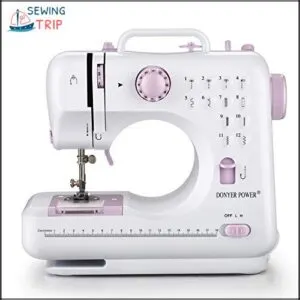
While many beginners dream of a feature-packed machine, the DONYER Power Portable delivers exactly what you need without overwhelming you.
This lightweight companion offers 12 preset stitches and dual speeds, making it perfect for small sewing projects.
You’ll love the built-in needle threader and choice between foot pedal or hand switch control.
The free arm helps with cuffs and sleeves, while on-board storage keeps your accessories organized.
Though it won’t handle denim, its portability features and accessory kit make it ideal for crafting on the go, providing a great sewing experience.
6. Beginner Sewing Machine Full Set
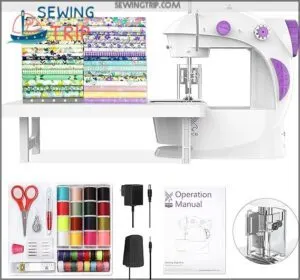
Through the KPCB Tech starter kit, you’ll discover everything needed to begin your sewing journey with confidence.
This compact beginner sewing machine comes packed with smart features that make learning a breeze.
For additional options, explore these best sewing machines for beginners.
- Handles up to 5 layers of fabric, perfect for small projects and basic repairs
- Includes 20 cotton fabric squares so you can practice right away
- Features easy-to-follow tutorial videos in six languages
- Comes with a complete toolkit including scissors, measuring tape, and thimble
- Built-in finger guard keeps your hands safe while learning
You’ll especially appreciate how this portable sewing machine takes the guesswork out of getting started.
The complete package means you won’t need to shop for additional tools or supplies, making it a great choice for those looking for a complete package with easy-to-follow instructions.
7. Speedy Stitcher Sewing Awl
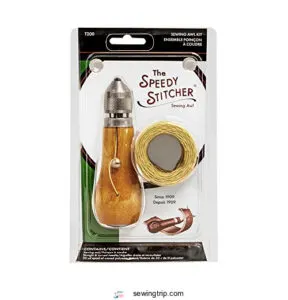
Looking for something different than standard mini machines? The Speedy Stitcher Sewing Awl might be just what you need.
This handheld powerhouse tackles tough materials like leather and canvas that would make regular portable sewing machines struggle.
You’ll love the solid wood handle – it gives you amazing thread control while keeping your fingers safe. The kit’s pretty complete too, with both straight and curved needles plus waxed thread included.
While it takes a bit of practice to nail the sewing speed and stitch quality, you’ll get the hang of those awl tips quickly.
Best For: Anyone who needs to fix heavy-duty materials, especially if you’re working outdoors or in tight spaces.
8. Singer Stitch Sew Quick 2 White Sewing Machine
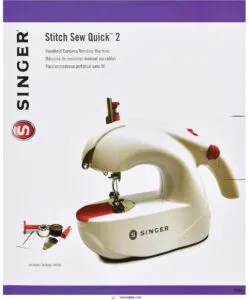
The Singer Stitch Sew Quick 2 packs powerful features into a portable sewing machine that’s perfect for your on-the-go needs.
When you’re traveling or need quick fixes, this mini sewing machine won’t weigh you down – it’s lighter than a laptop.
You’ll love the double thread feed system that keeps your stitches strong and even.
The automatic bobbin winder saves time, while the dual sewing speed lets you zip through simple hems or slow down for precise work.
The machine comes ready to use with threads, bobbins, and needles included.
Just pop in some batteries (not included), and you’re ready to tackle light to medium fabrics.
While it won’t replace your full-size Singer sewing machine, it’s your perfect travel companion for quick repairs and small projects.
Pro tip: Keep spare thread and a fresh set of batteries in the carrying case – you’ll thank yourself later!
Common Issues and Troubleshooting
You’ll find that even the best mini sewing machines can act up sometimes, but don’t worry – most problems have simple fixes.
Whether your machine’s making strange noises or the thread keeps breaking, we’ll show you exactly how to get your machine running smoothly again.
Not Sewing and Not Picking Up Bobbin Thread
Is your mini sewing machine refusing to stitch? Don’t worry – the fix is usually simple.
When your machine won’t sew or pick up the bobbins thread, start by checking your bobbin placement. It should spin counterclockwise to prevent thread tension issues.
Next, verify your needle sits at its highest point and your thread path matches your manual exactly. If you’re still having trouble, double-check that you’re using the right needle type for your fabric – this prevents skipped stitches and jammed threads.
Making Noise and Thread Breaking Issues
You hear noise, it’s likely loose parts or a dry machine. Check thread tension, it should feel gentle.
Poor thread or a dull needle can cause breaks. A thorough sewing machine noise diagnosis can pinpoint the problem.
Here are common issues:
- Jammed threads
- Skipped stitches
- Noise levels
Difficulties With Canvas Fabric and Heavy Materials
You’ll face canvas issues with thick fabrics.
Use a large needle, reduce speed, and guide gently.
Decrease thread tension and use heavy-duty thread for canvas fabric and heavy materials to avoid stitch problems and material limits due to fabric thickness, which can cause significant issues with thick fabrics.
Maintenance and Cleaning for Mini Machines
You keep your mini sewing machine happy with regular lubrication and needle care.
Clean the bobbin area after each project and store it dust-free.
This prevents problems and maintains smoother stitches.
Remember, oil changes and filter cleaning are key to mini sewing machine maintenance, just like dust removal and proper storage tips.
Getting The Best Value for Your Money
You want to get the best value for your money when buying a sewing machine for small projects.
By considering your budget, comparing features and prices, and thinking about additional costs, you can find a machine that meets your needs and fits your budget.
This approach allows you to make an informed decision and find a sewing machine that provides the best value for your investment.
Budgeting for a Mini Sewing Machine
You’re looking for a portable sewing machine.
Consider cost factors like accessories and warranties.
Here are budget tips:
- Set a budget
- Check prices
- Read reviews
- Compare features to get the best small sewing machine for beginners, an affordable sewing machine that meets your needs.
Comparing Features and Prices for Top Models
You’re comparing mini sewing machines.
Check the price comparison and feature sets. Model reviews can help. Consider sewing speed and durability tests.
Research current mini sewing machine prices online.
A portable sewing machine with the right features is key. Use this sewing machine buying guide to find the best small sewing machines for your needs.
Considering Additional Costs for Accessories
You’ll need to evaluate accessory costs, like thread expenses and bobbin prices, when purchasing a portable sewing machine.
A well-stocked sewing kit is essential for any sewing project.
Evaluate needle fees and storage costs to maximize value, and compare sewing machine accessories to find the best deals on sewing machine maintenance and comparison, considering the overall portable sewing machine.
Frequently Asked Questions (FAQs)
How do I choose a sewing machine for beginners?
You’ll want a machine with basic stitches, automatic threading, and a free arm, making it easy to sew small projects, like hemming pants or fixing buttons, with ease and precision.
Which sewing machine has the least problems for beginners?
You’ll find the SINGER Start 1304 has the least problems for beginners, offering easy dial selection and automatic features, making it a great choice for starting your sewing journey.
How much should I pay for a decent sewing machine?
You’ll likely pay between $80-$150 for a decent sewing machine that’s reliable and suitable for beginners, offering great value for small projects and everyday use.
How do I find the right sewing machine for me?
You’ll find the right sewing machine by considering your budget, project types, and desired features, then comparing models and reading user reviews to make an informed decision.
How to choose a sewing machine for beginners?
You’re a puzzle piece, and the right sewing machine is the perfect fit; consider your budget, project type, and skill level to choose a machine that’s just right for you.
How much should a beginner spend on a sewing machine?
You should spend around $150-300 on a sewing machine as a beginner, it’s a great starting point for basic projects and skills development.
Is it worth buying a cheap sewing machine?
You might save bucks, but a cheap sewing machine can be a false economy, leaving you frustrated with poor performance and broken dreams, so consider investing in a reliable one.
Can mini sewing machines handle stretchy fabrics?
You can handle stretchy fabrics with mini sewing machines, but choose the right needle size and use a walking foot for even feeding and smooth stitching results always.
Whats the typical lifespan of a mini machine?
What’s a mini machine’s lifespan? You can expect 5-7 years with proper care, depending on usage and maintenance, making them a great investment for small projects and beginners like you.
How much maintenance do mini machines need?
You’ll need to regularly clean and oil your machine to keep it running smoothly, and check the bobbin and needle for proper maintenance to maintain top performance always.
Conclusion
You’re now a pro at finding the perfect sewing machine for small projects.
Did you know 75% of sewers start with small projects?
You’ve got this, and with this sewing machine buying guide for small projects, you’ll find the best fit for your needs, making your small projects a breeze with the right sewing machine buying guide for small projects.
- https://sewingtrip.com/sewing-machine-buying-guide-for-small-projects/
- https://www.seamwork.com/articles/guide-buying-sewing-machine
- https://littlestitchstudionorfolk.com/blog/2023/11/14/c4smgk722lfzbdoqzu7g0cjeu9k4wu
- https://sewingfromhome.com/best/mini-sewing-machine/
- https://www.nytimes.com/wirecutter/reviews/best-sewing-machine/

